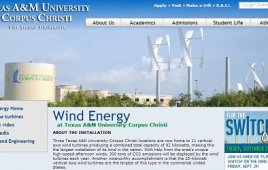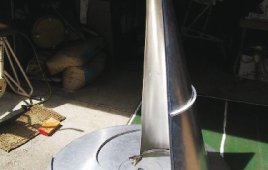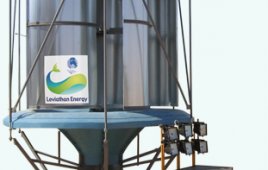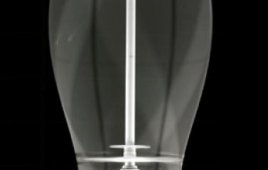Texas A&M University-Corpus Christi President Flavius Killebrew officially “flipped the switch” recently to turn on three 20-kW vertical axis wind turbines, which make up the largest vertical-axis wind turbine installation of its kind in the United States. The site at the main campus also includes a small 4-kW campus wind turbine, which can be lowered…
A wind turbine for commercial buildings
A windsail or vertical axis wind turbine is said to generate power on-site. It is also quiet, bird-friendly, likes turbulent winds, and catches the eye, says the developer. A few features some obvious and some less so include: It generates electricity on site and safely connects to the building’s electric power system. It is quiet.…
The right turbine and placement produces 10x power increase
The power output of a wind farm of vertical-axis designs can be increased about tenfold simply by placing the turbines so they react with each other, say researchers at the California Institute of Technology led by John Dabiri, Caltech professor of aeronautics and bioengineering, and colleagues during the summer of 2010. They have been conducting…
No Shortage of Amusing Wind Turbine Ideas
Arizona State architectural student, identified only as Joe, says his idea is to retrofit horizontal steel structures that currently hold freeway signs with two horizontal-axis wind turbines powered by the turbulence from passing cars. (Joe admits borrowing the turbine design from U.K. based quietrevolution). He figures (without showing figures) that with an average vehicle speed…
Vertical-axis turbines starts generating at less than 3 m/s
There are two basic types of wind turbines: vertical and horizontal axis. Each has pros and cons. Horizontal-axis turbines tend to capture more power per square meter of wind, but are noisier, vibrate more, present hazards to birds, require more empty space around them, and must be elevated away from people. Vertical-axis turbines, on the…
Vertical axis turbine works well atop office building
One forecast for small scale wind generators (sometimes called microgeneration) has them providing 30 to 40% of all the UK’s electricity needs by 2050. The British Wind Energy Association hints that with price trends for crude oil continuing up, the cost of small scale wind could be competitive with fossil fuels by as early as…






